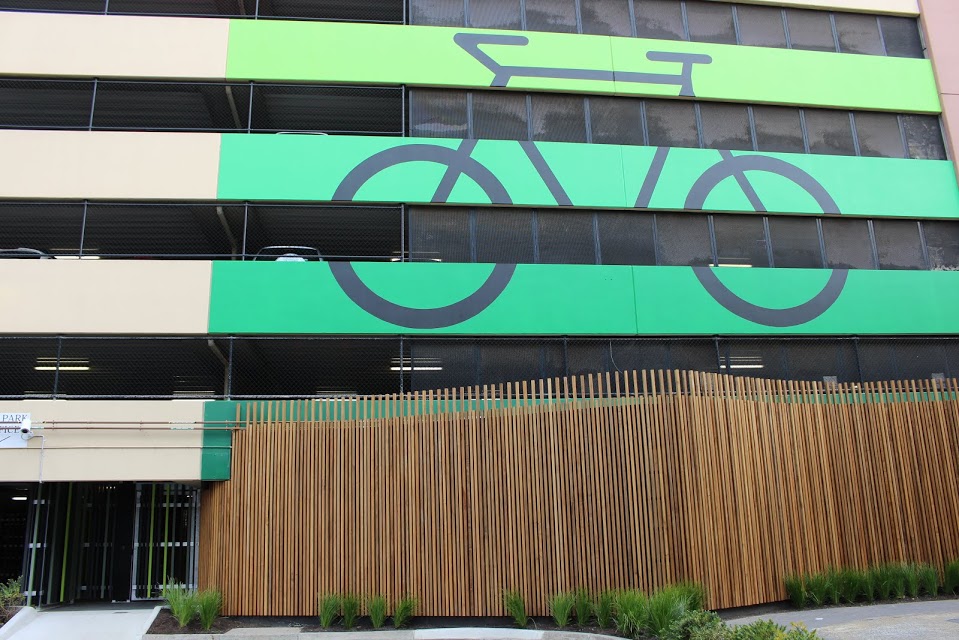-

Alfred Health
As the squeeze tightens on our public transport system and congestion grows on our roads, the daily commute can sometimes feel like a daily tough mudder, minus the endorphin rush. Whether you’re crawling along Hoddle St or jammed into an armpit on the Pakenham line, it’s enough to make you want to shower when you get to work.
Well some workplaces hear you and it’s showers, changerooms and all the mod-cons they’re building. But they want you to earn it by getting active on a bike or jogging to work. Why are workplaces investing in wellness? Because they know from research that keeping workers healthy boosts productivity by decreasing both absenteeism and ‘presenteeism’ (employees present at work but less productive due to illness, high stress, or injury).

Photo: Michael Hobbs
So it’s one thing to encourage employees to ride to work but it’s another to research, invest and construct an outstanding end-of-trip facility. About a year ago, Kirstan Corben from the Alfred Hospital of nearly 8000 staff, says she took “a leap of faith.” As the Lead for Health Promotion, she sought agreement to knock out 19 staff car parks and build a secure bike facility with 300 racks, along with showers and changerooms. Kirstan says the facilities that opened in August came about due to a need for more bike parking but also as an opportunity for time-poor staff to raise their activity levels. “I think it’s an easier sell than pushing an expensive gym membership on someone. Our staff are often so patient-focused they forget to look after themselves.”

Photo: Michael Hobbs.
She says while “we’re not about making everyone drive, we also know we’ll never fully meet the demand for car parking either. The new facilities provide a sustainable alternative and increase priorities for bikes, a kind of rebalancing.” When consulting designers, she asked to “improve the experience for existing riders and create a positive one for new riders.”

Alfred Health, photo: Karl Hilzinger
Wooden slatted fencing, colourful signage and a carpark defying amount of natural light make it an approachable, fun space to be in. People driving in won’t miss it either with a large bicycle symbol artfully spray painted above it – a not so subtle hint says Kirstan. “We want drivers to see people riding in, chatting away and connecting” she says. It’s these visible touches along with showers, changerooms and private lockers that can spark an increase in riders according to a 2014 Washington DC study that found more employees rode after end-of-trip facilities were installed.

Alfred Health, photo: Karl Hilzinger
Over at AGL in the Docklands, an aptly named workplace riding group, ‘Pedal Power’, helped result in the construction of its new bike facilities. AGL employee, Nick Franco spearheads the 130 member workplace BUG (bicycle user group) and says they’ve had a “strong influence” on the project completed in June that turned what was 88 car spaces into 33. There’s now a bike rack for one in four staff members.

AGL Bicycle User Group, photo: Hormuzd Khodaiji
Change Lead Manager, Chris Cundy who oversaw the project from start to finish says the bike facilities are in keeping with the newly built Docklands tower which has a green energy rating three times higher than the minimum requirements. “Our objective was to have the best facilities in Melbourne, full stop” says Cundy. With 270 bike spaces, 402 lockers and even dehumidifying drying cabinets for those wet weather days, it’s fair to say he’s provided that. The key test will be in warmer months however, when Chris hopes the vast grey spaces that now dominate the site are filled with bikes and the hot blood of riders.
An environment which Kirstan says puts workers “on the same level” and starts conversations between people that may never interact otherwise. It seems apt that Kirstan herself only began riding two years ago when a colleague dared her to. She took up the challenge, rode the 26 kilometer journey and has been riding in most days ever since. She says “people I helped a year ago, I now see helping others ride to work with a recommended route or place to buy a bike.”
It’s this bold approach to health promotion and sustainability that pulls rather than pushes employees to change their behaviour, that workplaces should take inspiration from. It seems a bike-friendly workplace is a people-friendly workplace too.

Alfred Health, photo: Karl Hilzinger
Words: Michael Hobbs.